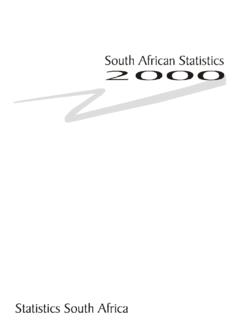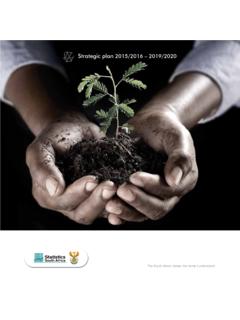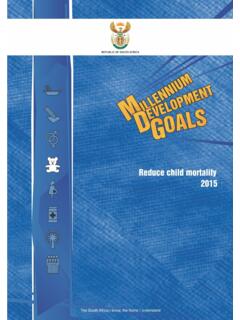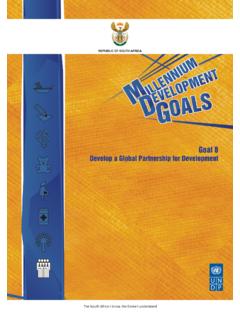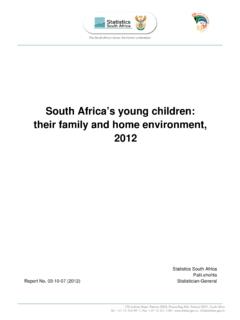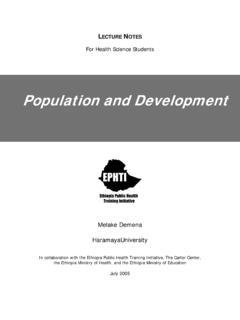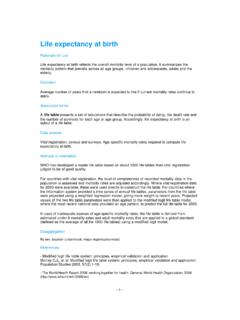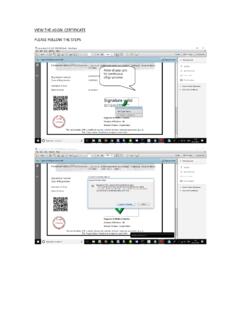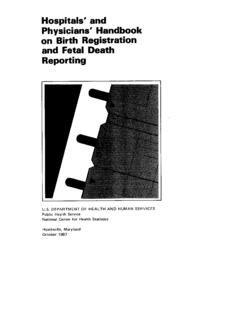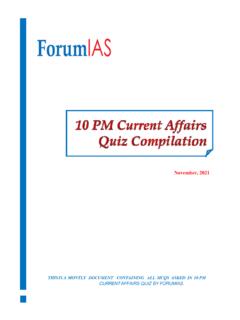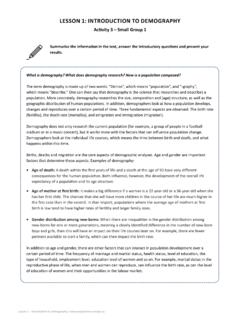Transcription of STATISTICAL RELEASE - Statistics South Africa
1 Private Bag X44, Pretoria, 0001, South Africa , ISIbalo House, Koch Street, Salvokop, Pretoria, 0002 , Tel +27 12 310 8911 STATISTICAL RELEASE P0302 Mid-year population estimates 2020 Embargoed until: 9th July 2020 10:30 ENQUIRIES: FORTHCOMING ISSUE: EXPECTED RELEASE DATE User Information Services 2021 31 July 2021 Tel:(012)310 8600/4892/8390 Statistics South Africa ii P0302 Mid-year population estimates, 2020 Contents Acronyms and abbreviations .. iv Definitions and .. viii Covid-19 implication of MYPE 2020 .vi 1. Introduction .. 1 2. Demographic and other assumptions .. 2 3. Demographic and other indicators .. 4 4. National population estimates .. 9 5. Provincial population estimates .. 12 Demographic assumptions .. 12 Migration patterns .. 15 Provincial distributions .. 17 References .. 21 Appendices .. 23 List of tables Table 1: Mid-year population estimates for South Africa by population group and sex, 2020.
2 Ix Table 2: Assumptions of expectation of life at birth without HIV/AIDS and total fertility rate, 2002 2020 .. 3 Table 3: International net-migration assumptions for the period 1985 2021 .. 3 Table 4: Births and deaths for the period 2002 2020 .. 7 Table 5: Mid-year population estimates by population group and sex, 2020 .. 9 Table 6: Mid-year population estimates by population group, age and sex, 2020 .. 11 Table 7: Estimated provincial migration streams 2006 2011 .. 15 Table 8: Estimated provincial migration streams 2011 2016 .. 16 Table 9: Estimated provincial migration streams 2016 2021 .. 16 Table 10: Percentage distribution of the projected provincial share of the total population, 2002 2020 .. 17 Table 11 (a): Provincial mid-year population estimates by age and sex, 2020 .. 17 Table 11 (b): Provincial mid-year population estimates by age and sex, 2020 (concluded) .. 19 Statistics South Africa iii P0302 Mid-year population estimates, 2020 List of figures Figure 1: Mid-year population estimates for South Africa by province, 2020.
3 Ix Figure 2: Crude birth rate, crude death rate, and rate of natural increase over time, 2002 2020 .. 5 Figure 3: Life expectancy by sex over time, 2002 2020 .. 6 Figure 4: IMR, U5MR and CDR over time, 2002 2020 .. 6 Figure 5: HIV prevalence by selected age groups, 2002 2020 .. 8 Figure 6: HIV Population over time, 2002 2020 .. 8 Figure 7: Population growth rates by selected age groups over time, 2002 2020 .. 10 Figure 8: Provincial average total fertility rate over time, 2001 2021 .. 12 Figure 9: Provincial average total fertility rate, 2016 2021 .. 13 Figure 10: Provincial average life expectancy at birth (males) .. 17 Figure 11: Provincial average life expectancy at birth (females) .. 14 Figure 12: Population under 15 years of age .. 20 Figure 13: Proportion of elderly aged 60+ .. 20 Statistics South Africa iv P0302 Mid-year population estimates, 2020 Acronyms and abbreviations AIDS acquired immune deficiency syndrome AIM AIDS Impact model ANC antenatal care ART antiretroviral therapy CBR crude birth rate CDR crude death rate DemProj Demographic projections HIV human immunodeficiency syndrome IMF International Monetary Fund IMR infant mortality rate IOM International Organisation for Migration NSO National STATISTICAL Organisation OECD The Organisation for Economic Co-operation and Development PMTCT prevention of mother-to-child transmission PLWHIV People living with HIV RAPID Rapid Mortality Surveillance RNI rate of natural increase SDDS Special Data Dissemination Standards Stats SA Statistics South Africa TFR total fertility rate U5MR under-five mortality rate COVID-19 coronavirus disease 2019 Statistics South Africa v P0302 Mid-year population estimates.
4 2020 Definition of concepts Age-specific fertility rate (ASFR) The age-specific fertility rate measures the annual number of births to women of a specified age or age group per 1 000 women in that age group. Annual growth rate (GR) The rate at which the population is increasing or decreasing in a given year due to natural increase and net migration, expressed as a percentage of the base population. Cohort component projection A projection made by subjecting all cohorts, on an annual or five-year basis, to mortality and migration assumptions, and applying fertility assumptions to women of reproductive age. Crude birth rate (CBR) The number of live births per 1 000 population in a given year. Crude death rate (CDR) The number of deaths per 1 000 population in a given year Life expectancy (e(0)) The average number of years a new-born can expect to live based on the mortality conditions at the time. Life table A table of values based on a series of related functions having to do with survivorship over intervals of time.
5 Population projection Computations depicting the future course of a population s size, its structure, and its interaction with dynamics such as fertility, mortality, and migration. The projection is constructed based on assumptions about the future course of those population dynamics. Rate of natural increase (RNI) The rate at which the population is increasing or decreasing in a given year due to the surplus or deficit of births over deaths, expressed as a percentage of the base population. Sex ratio The number of males per 100 females in a population. Total fertility rate (TFR) The average number of children that would be born alive to a woman (or a group of women) during her lifetime if she were to pass through all her childbearing years conforming to the age-specific fertility rates of a given year. Under five-mortality rate (U5MR) The number of deaths to children under the age of five per 1 000 live births.
6 Statistics South Africa vi P0302 Mid-year population estimates, 2020 COVID-19 implications for MYPE 2020 series On 5 March 2020, South Africa recorded it first case of Covid-19. By the 11th of March, the WHO declared Covid-19 a global pandemic. South Africa s first Covid-19 related death occurred on 27 March. Subsequently, President Ramaphosa announced an international travel ban, amongst other measures, and by early April, the age mortality profile of the disease was shared with health practitioners, academics, statisticians and planners (Stokes et al., 2020). Countries which have populations that are on average older, (which tend to be the more developed countries), experienced significantly higher numbers of Covid-related deaths among their elderly. However, developed countries also have better functioning health systems. Although the health burden may be greater in developed countries due to their age profile, they have greater ability to meet it.
7 South Africa , recognising its vulnerabilities, immediately responded with a lockdown to curb the spread and flatten the curve to provide healthcare systems the opportunity to prepare. Deaths due to Covid-19 are yet to be published in the vital registration of deaths system in South Africa . However, the South African Medical Research Council (SAMRC) has published weekly Covid-19 related deaths limited to those with a legal/ valid South African ID document and those aged more than one year. By 30 June, the reference date of the mid-year population estimates, approximately 152 000 confirmed Covid-19 infection cases and 2 700 confirmed Covid-related deaths were reported in South Africa . To date the current number of deaths directly related to Covid-19 are marginal in comparison to the overall count of deaths in a given year (MCOD, 2020). As the spread of the disease occurs over time, we are bound to see a rise in the number of deaths in the population due to Covid-19.
8 However, we are also likely to see innovation in treatment protocols and prevention measures. To include speculative annual Covid-related deaths without sufficient trend data will create a far greater uncertain set of population estimates for current planning and decision-making. Population estimates are necessary to ensure that government and various other sectors, including health, education and business, plan effectively for South Africa . The mid-year estimates provide an indication of the distribution of the population by sex, age, population group, and province. The net migration rate can be volatile, impacted significantly by economic and policy changes, as encountered in the recent outbreak of Covid-19 in March 2020. Due to the international travel ban, travel was brought to an abrupt halt in the country, even between provinces (except for certain special cases such as burials for which permission had to be sought from the relevant authority.)
9 International migration assumptions by sex assume a decline post March 2020. International migration for the period April 2020 June 2021 at national level is assumed to have declined, reflective of current lockdown regulations. Provincial estimates are produced for the 5-year period 2016 2021. International travel is likely to continue to remain at very low levels until such time a vaccine is developed and administered, which conservative estimates place to be between 12 18 months. The impact of Covid-19 on conception and subsequently the expected births in 2021 is anticipated to decline given the escalation in economic uncertainty. However, empirical data to this effect will only be reflected in the reported births of 2021. For this reason, current assumptions of national and provincial fertility are based on trends seen in published births data currently available. Statistics South Africa vii P0302 Mid-year population estimates, 2020 The mid-year population estimates produces not only national indicators and estimates but also provincial estimates.
10 In developing provincial estimates, the distribution of annual birth and death data by province available in the published vital registration system (MCOD, 2019), are used. The impact of Covid-19 infection and death varies significantly across the 9 provinces. Western Cape has been declared the epicentre of Covid-19 in terms of number of infections and deaths for the months of May and June. The South African Covid-19 Modelling Consortium anticipate that epidemics in KwaZulu-Natal, Gauteng and Western Cape are expected to peak earlier, whilst other provinces will trail behind. The consortium acknowledges that models do not account for population-wide behaviour changes in response to high levels of mortality and understanding of the virus s epidemiology is continually evolving, both locally and globally (SACMC, 2020). For the purpose of the publication of this Mid-year estimates, we have cautiously adopted to base our estimates on current empirical data sources used to guide the estimates.
